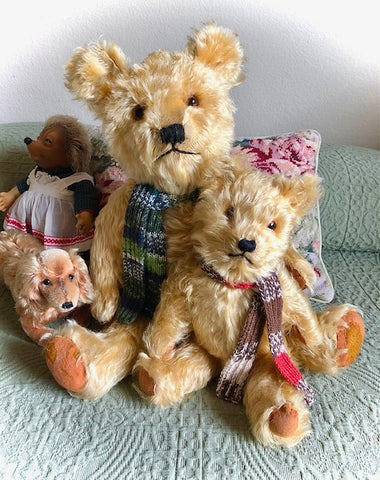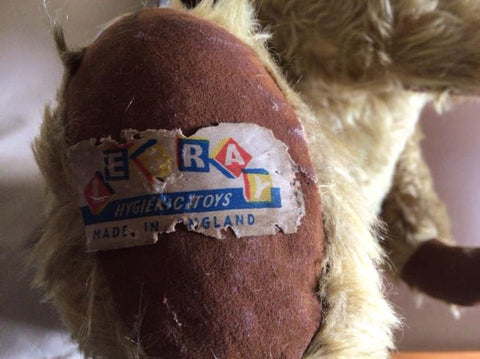Australian Joy Toys (1930) Label
Joy Toys Australia operated
from the 1920s until the early 1970s, ceasing production in the early 1970s after being taken over by the British company Cyclops in 1966. The company was founded in the 1920s, with significant expansion occurring after 1937.
- 1920s: Joy Toys was founded in Melbourne by Gerald and his wife, likely becoming the first Australian teddy bear factory.
- ~1935: The company began producing Disney characters under license, which helped its initial struggles.
- 1937: The original founders, the Kirby's, left for London, and the company expanded under new management.
- 1966: The company was taken over by the British company, Cyclops.
- Early 1970s: Production was shut down.
- Label: The primary identifier is a label. Authentic Joy Toys bears typically have a white label on the right sole of the foot, with the words "Joy-Toys made in Australia" in green sewn letters. Bears from different eras might have had labels in other locations, such as a shoulder seam.
- Neck Jointing: A significant characteristic of Joy Toys bears (especially post-WWII) is the unmovable (unjointed) neck. The head is often fixed in position, which is a key differentiator from many other brands of the time.
- Nose: The bears often have a characteristic square or oblong nose. The stitching pattern of the nose can be a helpful detail; document its shape and any specific stitching patterns, such as upturned stitches at the ends.
- Eyes: Joy Toys commonly used glass eyes (which can be clear, black, or two-colored composite glass). Post-war bears might have plastic eyes.
- Stuffing: Early bears were typically stuffed with wood wool (excelsior), while later ones from the 1950s and 60s used softer fillings like kapok or foam rubber chips.
- Joints: The limbs are usually joined with firm discs (early ones with metal or cardboard discs, later with wooden or firm material) allowing for movement, but the neck remains unjointed.
- Material: Most Joy Toys bears were made of mohair or plush. The paw pads were often made of felt, velveteen, or rexine (a painted cotton material).
Steps for Identification
- Look for the Label: The first and most reliable step is to check for any existing labels, particularly on the right foot pad.
- Examine the Neck: Check if the head can rotate. If it is firmly fixed, it is a strong indicator of a Joy Toys bear.
- Note Physical Details: Document the type of eyes (glass or plastic), the material (mohair/plush), the stuffing feel (hard/soft), the number of claws (Joy Toys bears may have no claws), and the nose's shape and stitching pattern.
- Compare Features to Eras: The company produced toys from the 1920s to the 1970s, so characteristics may vary slightly by decade.
If a label is missing, identifying the bear may require consultation with a teddy bear expert or comparing its specific features with detailed reference guides and online resources for vintage Australian teddy bears.
Description
| Date | 1930 |
| Make | Joy Toys |
| Button | |
| Label | yes |
| Fabric | Mohair Blond |
| Size | 17 ins |
| Eyes | Glass |
| Features | Rare label |
| Jointed | 4 Ways Jointed. Fixed head |
| Pads | Cloth |
| Stuffing | Woodwool |
| Clothes | |
| Growl | |
| Number | 433 |





Share this item: